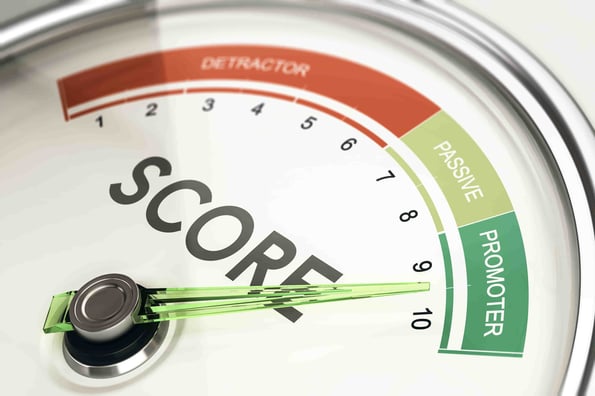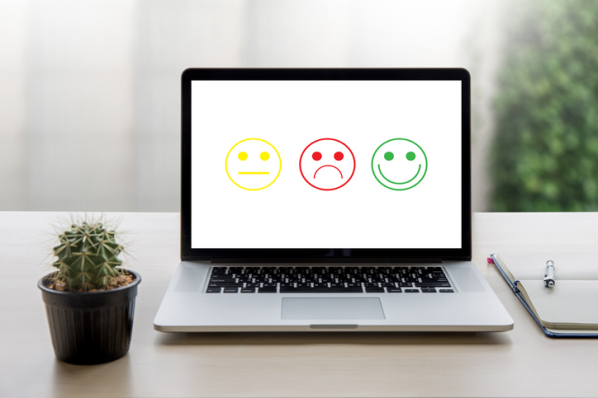Net Promoter Score (NPS®) is a measure of customer loyalty. Unlike other consumer metrics, like the customer satisfaction score and customer effort score, the NPS® is used to understand consumers' overall feelings towards a brand, and their likeliness to recommend it to friends and family.

This data comes from surveys, where customers are asked, "How likely are you to recommend XYZ brand to a friend," and prompted to select a number on a scale of 1 to 10.
In 2018, a HubSpot survey found that 81% of consumers trust their friends and family's advice over a business's advice. Considering this, the influence that your NPS® can have is significant.
You probably already know what your NPS® score is, so now it's essential to understand what the numbers mean. ![→ Download Now: Customer Service Metrics Calculator [Free Tool]](https://no-cache.hubspot.com/cta/default/53/e24dc302-9dc2-466f-a5ca-ab4e08633c0f.png)
NPS® Score Ranges
On a scale of -100 to 100, your business either has a good NPS® score or a bad NPS® score.
It is important to note that labeling individual scores as good or bad varies by industry; however, a score above 60 in any industry is an excellent score. A higher score also means that your brand has more promoters than detractors.
What is a good NPS® score?
Any score above zero is a good NPS®score. It shows that the majority of your customers are promoters. However, a good score over zero can be a 25, which indicates that there is room for further improvement.
If it's any consolation, a perfect score of 100 is infrequent. Companies that are considered industry standard typically have scores between 60 and 70.
In 2019, Netflix had a score of 68, Starbucks had a 77, and AirBnB had a 74.
What is a bad NPS® score?
A bad NPS® score is a score below zero. It shows that your business has more detractors than promoters, but more on what that means later. A negative score should signal to you that there is work to be done to improve your score and improve the overall customer experience with your brand.
If you've found that your score shows that there is room for growth, here are six things you can do to improve your NPS® score and strengthen the relationships you have with your customers.
Featured Resource:Customer Service Metrics Calculator
To calculate and track your business’ Net Promoter Score, use HubSpot’s free customer service metrics calculator. The download includes excel templates to regularly track ten different customer service metrics, all in one place.
How To Improve Your NPS® Score
- Involve everyone.
- Set realistic goals.
- Make it easy for customers to promote your brand.
- Listen to your customers.
- Learn from your customers.
- Monitor your score.
1. Involve everyone.
All teams within your organization should participate in the process of improving your score. That means C-Suite executives, customer-facing staff, the UX team — everyone.
Everyone should understand what NPS® scores are, your current NPS® score, and what steps will be taken to raise it.
Consider calling monthly meetings to discuss progress, and sending out memos when you reach important milestones.
People should be excited to engage in this process, as raising the score means delighting more customers and improving your brand's overall perception.
2. Set realistic goals.
It's important for all employees involved to feel as though your NPS® goals are realistic so people don’t feel defeated if targets aren’t being met as expected.
If your current score is 30, it's understandable that you may want to reach 50. However, it may take a significant amount of time. Setting short term goals will allow you to be more successful without experiencing employee burnout.
Setting goals in increments of 10 can help get an accurate assessment of how your growth is happening. Perhaps you’ll set a goal of bringing your score from 30 to 40 over a period of six months.
3. Make it easy for customers to promote your brand.
Keep customers engaged with activities like giveaways and contests. You don't want them to use your service and move on — keep them coming back.
Give them reasons to want to promote your products. If they're excited about it, they'll respond to your surveys with 9s and10s, letting you know that they want to recommend you to their friends and family.
4. Learn from your customers.
Encourage your customers to take your surveys and share their experiences with your brand. Positive reviews are visible to all, and they may convince the next unsure customer to purchase your product over a competitor.
It's important to note that keeping customers engaged is necessary when asking them to become promoters. Just like people hate being cold-called, customers don't want to be asked for feedback when they haven't had any previous contact with you. Reach out to them and learn from what they have to say.
There are three groups to focus on when following up with your customers: detractors, passives, and promoters.
Detractors
These are the customers responding to your surveys with scores between 0 and 6. Although their feedback may be negative, it's also the most useful for improvement. Reaching out to them after they give negative feedback is critical, as solving their issues and making them feel heard may convert them to promoters.
Passives
Passives are responding with scores of seven and eight. They aren't promoting your brand, but they're also not giving negative reviews. Passives can be converted to promoters, but you should spend time understanding their pain points. Creating a personal connection with them may push them to become promoters.
Promoters
Promoters are your ultimate supporters, but they still need your attention. It would help if you devised efforts to keep them happy. They can offer insight into what you're doing right. Neglecting them may push them to become passives or even detractors.
5. Listen to your customers.
Follow up with your customers and document and categorize their feedback within your preferred CRM software. Use their feedback to adapt strategies based on their responses. If multiple customers repeatedly report similar issues, this should signal to you that there is an area for change that has not been addressed. This is a crucial step to improving your score.
6. Monitor your score
Once you've begun your score-raising strategy, you want to know if it's working.
Devise time frames in which you'll recalculate your score and assess your progress. Maybe that's twice a week, once a month, or once every three months. If you're taking the right steps, you should see improvement.
Ultimately, you should see your Net Promoter Score® as a measure for improvement. Communicating with the customers that drive your revenue can help you redesign your customer experience and identify ways to improve your business..
The more promoters you have, the more customers they'll refer to you, and the higher your score will be.
Net Promoter, Net Promoter System, Net Promoter Score®, NPS®, and the NPS-related emoticons are registered trademarks of Bain & Company, Inc., Fred Reichheld, and Satmetrix Systems, Inc.


![How I Calculate Net Promoter Score [Formula & Examples]](https://knowledge.hubspot.com/hubfs/how-to-calculate-nps-1-20241104-8187591.webp)








